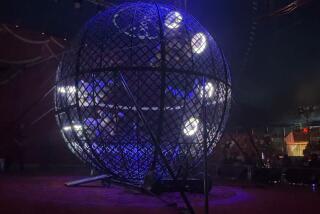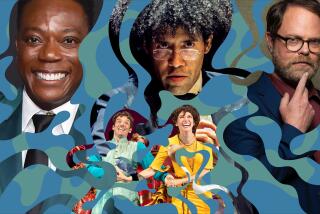A Festival That’s All Over the Map
- Share via
EDINBURGH, Scotland — The annual all-day, all-night midsummer’s dream that has blossomed into one of the world’s largest arts festival ends here today to the hoarse cheers of tired theatergoers, critics, wannabe stars and street musicians.
Over the past three weeks, all have played cast and public in a civic display of brio that spills--sublime to sophomoric--from elegant theaters and makeshift stages into the buoyant, never-sleep streets of Scotland’s capital city. Forget all those preconceptions of dour Scots: While most of Western Europe sleeps through August, Edinburgh throbs.
As usual, the formal Edinburgh International Festival, marking its 50th birthday this summer, has been the most--and the least--of Scotland’s summer soiree. Integral to Edinburgh’s buzz are thousands of discover-me-please performers who thrive on the pulse-racing, kaleidoscopic edges of the mainline festival in an off-Broadway exuberance of their own called the Fringe.
Nancy Hartman came to the Fringe from Laguna Beach one understanding husband, two kids and seven years after first wandering into festival Edinburgh at the end of an unhappy love affair. At 10:30 every night, she’s been performing “Smart Women, Stupid Choices,” a satire on talk shows and motivational seminars, on the third floor of the building Edinburgh University uses for matriculation and exams. Wouldn’t have missed it, says Hartman.
“It’s a ridiculous thing to do, really,” she said. “You need to find a venue where you can perform, find a place to live, do your own publicity. Then, you’re lucky if you break even. But I wanted to perform 20 times before an audience every night. I thought my show was a little racy, but then I saw Fringe posters for the naked Australian lesbian trapeze artists.”
The festival sold $3.6 million in tickets for 225 performances and drew about 420,000 spectators, including free events. The Fringe sells its own tickets and may draw another 1 million spectators.
“I want to change your life,” smiles festival director Brian McMaster, who says his mandate is to “project to a foreign audience the particular heart of Scotland, and to project an international dimension to the people of Scotland.”
Such open windows bring gusts of fresh air through a granite-ribbed city laden with history and crowned by an ancient hilltop castle. These include: the Strauss work “Ariadne auf Naxos,” as performed by the Scottish Opera; Spanish and British theater; American dance; Scottish choral recitals; Chinese drama; Shakespeare’s “Measure for Measure”; lectures; debates; recordings; organ recitals; performances by trios and quartets; concerts by symphony orchestras from Hamburg, Edinburgh, Budapest.
The biggest festival hits, McMaster says, have included La Cubana, a Catalan company blending film and theater; American mezzo-soprano Michelle DeYoung; and eight sold-out performances of songs sung in Scottish Gaelic.
Americans sang and also danced. The San Francisco Ballet and “Tharp!”--a presentation of new dance by Twyla Tharp--were among big draws that also included the world premiere of “Fish” by the Bangarra Dance Theater, stories of indigenous Australians by aboriginal choreographer Stephen Page.
McMaster waves off critics who complain a festival begun in the bleak postwar years has lost its verve and its focus in middle age. “We are not selling out doing populist things, and more people want to come than ever. That’s the acid test. The festival is revelatory to me--and to a whole lot of other people.”
McMaster is already booking for next year’s festival, taking place Aug. 16-Sept. 5.
Once again, Edinburgh’s population effectively doubled this year to a plugged-in 1 million for the extraordinary cultural harvest. About 50% of visitors are from Scotland, 30% from the rest of Britain and the remaining 20% are foreigners, mostly Western Europeans.
For many festival-goers, it is not the blue-ribbon events that are most compelling but the happenings that frolic in their wake: simultaneous festivals of books, jazz, film and television. One summer sellout is a nightly military tattoo, swirling pipes and kilted soldiers, in the forecourt of Edinburgh Castle.
Dwarfing them all for sheer numbers is the Fringe, an anything-goes multivenue potpourri, a dazzling succession of early morning until wee hours performances by dreamers waiting for a magic phone call from European and American promoters patrolling amid the jeans and backpacks of the young majority. Across three weeks, they have more than 600 companies to choose from.
“The Fringe is total anarchy and wonderful. Add all the other festivals to ours, and we are not only the biggest in the world--we are unique,” McMaster said. “People come for one thing or another and get caught up in the spirit,” ringmaster McMaster said with a twinkle in an interview.
The voice of the Fringe is Edinburgh’s review-everything newspaper the Scotsman, which publishes a daily 24-page festival section. “It has been a brilliant festival this year--ebullient,” said managing editor Alan Taylor, who directed the coverage. “In context, this year has marked the demise of stand-up comedians and the resurrection of drama and theater.”
One major Fringe site this year is a university building renamed the Famous Grouse House for the festival where artistic director Hugh Loughlin booked 71 companies, which together gave more than 400 performances. “I try to offer a venue for work, particularly Scottish work, that might not otherwise be seen. And I’m not afraid to schedule across art forms and skill levels,” Loughlin said.
Famous Grouse publicist Stephanie Noblett observed: “Think of us as a laboratory and a springboard driven by market force and blind conviction. Sometimes it works and sometimes it fails. There’s a lot of crap.”
Among the well-reviewed serious Fringe theater was “Vagabond John,” a one-man show by San Franciscan Bill Ritch based on the writings of Scottish American conservationist John Muir, the father of America’s national parks.
Ritch, 54, a graduate of West Point and a retired Army major, wrote the play while living for two years in an alternative community in Northern Scotland recovering from post-traumatic stress that was a legacy of combat in Vietnam. Using flashbacks, dreams, memories and hallucinations, Ritch illustrates Muir’s battle to resolve internal conflicts between his desires to stay in the Sierra Nevadas and pressures to return to society.
“Appearing at the Fringe is a great crap shoot,” Ritch said. “Last year, I didn’t get reviewed until the sixth show, and the review wasn’t published until after the 12th show. I had a five-star review, but I played to audiences of between 10 and 60 people.”
Major festival events regularly fill a 3,000-seat theater, but an audience in the teens is respectable on the Fringe. The rule is that a company may renege on a performance if the cast outnumbers the audience, but Fringers tend to be wary: Everybody remembers the sad story of a stand-up comic who realized too late that the only person who turned up for one performance was a Scotsman reviewer.
More to Read
The biggest entertainment stories
Get our big stories about Hollywood, film, television, music, arts, culture and more right in your inbox as soon as they publish.
You may occasionally receive promotional content from the Los Angeles Times.










